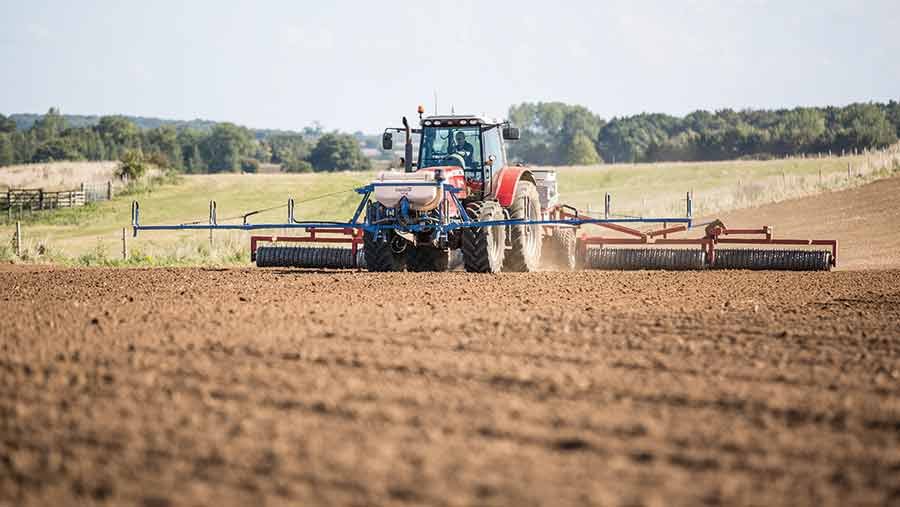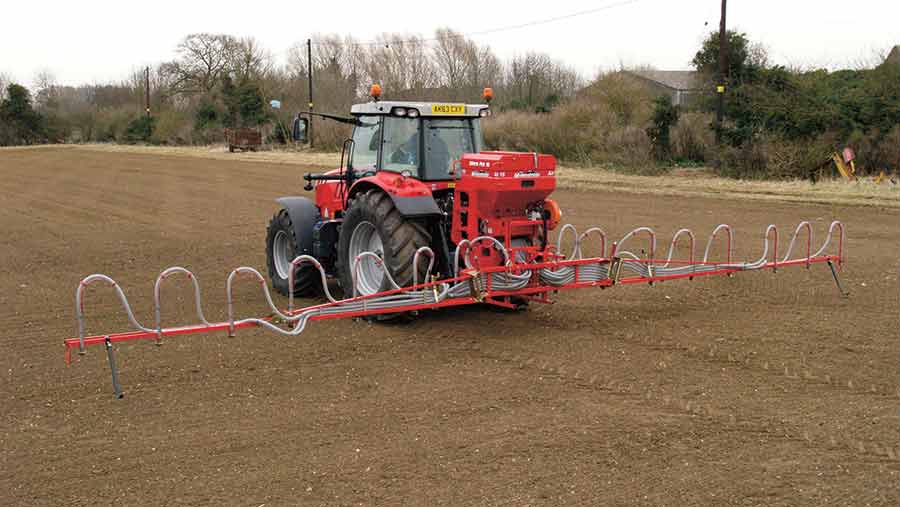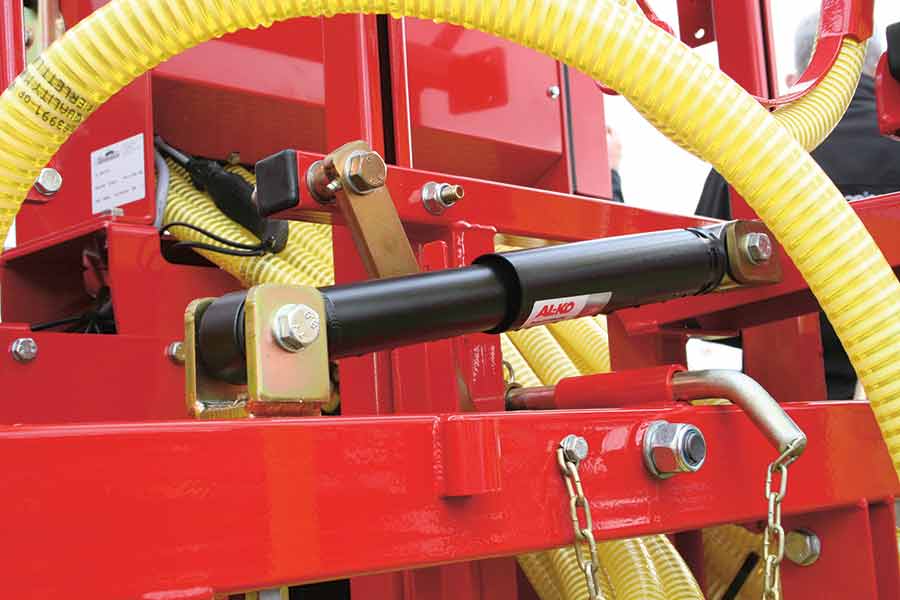Farmers rate their Horstine and Opico Avadex applicators
Specialist applicators and boom fertiliser spreaders capable of handling microgranules will be in action this autumn as growers broaden their approach to grassweed control.
Applying Avadex Excel 15G – a once-popular herbicide enjoying a major comeback – has become a key component of control programmes once more now that foliar weed killers have become less effective, in particular against blackgrass.
With a mode of action different from almost all other autumn-applied herbicides, the granular material can play a useful role in lifting the overall performance of a herbicide programme, particularly in winter barley, where there are few active ingredient options.
See also: Eight of the best slug pelleters on test
Application accuracy is essential, though: the recommended rate of 15kg/ha equates to just two granules/sq cm. Even distribution is therefore crucial.

Jim Hammond
Jim Hammond of SCS Spreader & Sprayer Testing has tested a lot of applicators – partly because they have to be checked under the NSTS scheme, and partly because growers recognise the need for distribution accuracy.
“I would estimate there is probably an even split between machines that are pretty much spot on and those that need adjusting to get things just right,” he says.
“Even distribution is important for cost-effective use of fertilisers, but with Avadex granules it is crucial because of the small amount of material going on.”
The required NSTS test (costing £180) is limited to checking that the applicator delivers the correct rate of herbicide, plus or minus 10%, but not the distribution pattern.
This is optional at an extra £50 for a dynamic test, running an applicator over a set of collection trays.
A static test – of an applicator system on a set of rolls, for example – is charged at £255. It takes longer because more trays have to be deployed and the contents collected and weighed.
Influences on spread pattern
Metering, evenness of airflow at the outlets and the angle of the distribution plates are key influences on the spread pattern.
“On some machines, the correct angle of the deflector plates is clearly defined, which makes checking and adjustment relatively easy,” says Mr Hammond.
“But on others, there is no such guidance and the angle has to be judged by eye. So if one or more plates has been knocked during transit or by a ground impact, it’s a case of setting them as close as possible to their neighbours.”
Angle them too far down and the granules will likely fall short; too high and more will be deflected further sideways than behind. Only a tray test will determine if everything is spot on across the full width of the applicator.
Avadex manufacturer Gowan provides calibration and set-up guidance for applicators online and dummy granules for pattern evaluation by professional testing services. Calibration must be carried out using the real thing.
Horstine Farmery TMA4 – Terrace Hills Farm

Brendon Stanley
With production of the TMA4 having resumed as a result of the resurgent use of Avadex, Brendan Stanley, former farm manager at Terrace Hills Farm, near Grantham, Lincolnshire, was able to buy a new model instead of hunting down a used one.
“Besides, it made no sense to wait for a second-hand one because they hold their value and a new one at the time was almost the same price,” he says.
Although blackgrass has not been a major issue, it has appeared in some fields this year and wild oats and sterile brome represent an ongoing challenge on much of the farm’s 1,300ha arable area.
“Initially, we wanted to mount the TMA4 on a set of rolls, but we had a spare tractor with front linkage, so it made sense to make use of it,” says Mr Stanley.
“That meant we could apply granules as part of the rolling operation and apply slug pellets at the same time, or put on the Avadex separately if it was not too wet to roll.”

Having the applicator on the front linkage means the herbicide can be applied as an individual operation or while rolling
A key attraction of the Horstine Farmery machine is its metering system, which provides individual metering for each outlet. They are spaced 1.5m apart across the 12m working width.
“The problem with having only one metering unit for all the outlets is that there is nothing to stop the product going down one pipe,” Mr Stanley suggests. “Avadex applied with a poorly calibrated or badly set up applicator can result in terrible striping.”
Opico Micro Pro 16 – Kings Barn Farm

Jeremy Fulcher
Avadex granules were introduced to the blackgrass control programme for the first time last year at Kings Barn Farm, near Dunmow, Essex, along with an Opico Micro Pro 16 applicator.
“We looked at various options, including having an applicator on the drill or on a set of rolls, but came up with reasons not to in both cases,” says manager Jeremy Fulcher.
“We wanted drilling to be the priority without distraction.
Additionally, the operator didn’t have the necessary qualifications and if it’s too wet to roll, then you can’t get the herbicide on if you go down that route.
“The logical conclusion was to accept it would be a separate tractor operation.”
After checking out different applicators, the Micro Pro 16 was chosen, partly because of the good service provided for a similar subsoiler-mounted unit used for sowing oilseed rape and also because of the individual metering for each outlet.

The Opico Micro Pro 16 is available in tractor, implement and chassis-mounted formats
“A good bit of thought has gone into the distribution plate design and the electric drive to the metering rollers, which allows them to be ‘shaken’ to keep everything clean and running accurately,” Mr Fulcher adds.
“I also like having a read-out of the fan speed on the control box in the cab; it’s reassuring to see it running correctly and means you can make fine adjustments to the hydraulic drive if necessary.”
The 12m linkage-mounted applicator looks a little out of place on the back of a 180hp tractor, but there is nothing smaller on the farm – and it does provide a stable base to help keep the boom on an even keel.

Modifications to the Opico Micro Pro include fitting a telescopic damper on either side of the central frame
In common with other examples already in service, Mr Fulcher’s Micro Pro is having the new central boom section with twin shock absorbers fitted to reduce exaggerated yaw and sway on rougher ground.
Together with a new outer section tension bar on each side, the modifications – undertaken by Opico without charge – should deliver a smoother ride to ensure the best possible product distribution.
“It’s an expensive herbicide to put on and, of course, for efficacy it has to go on right,” emphasises Mr Fulcher.

